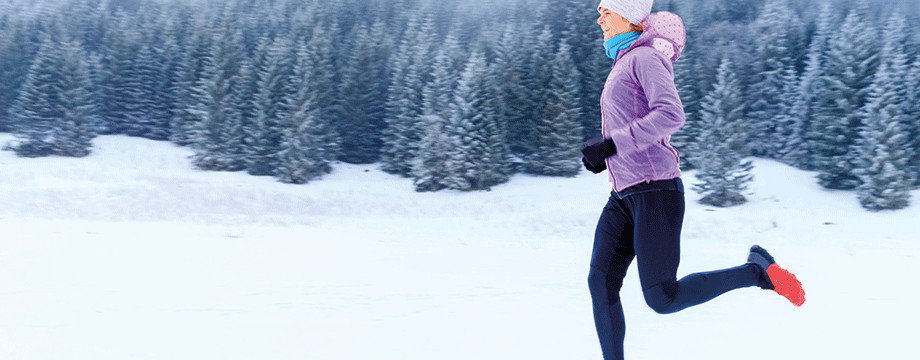How to be a winter warrior!

Keep up your winter running routine with these expert tips
Running in the summer time is so much more appealing than the winter. It can be very tempting to put your trainers to one side and get cosy under a blanket instead. However you will soon notice your fitness levels dropping if you don’t maintain a regular exercise routine. Here are three ways to keep training whilst keeping injuries at bay this winter.
1. Look after your joints
Aches and pains from inflamed joints are made so much worse by the cold and can really put you off going outside to exercise. Shona Wilkinson, nutritionist from SuperfoodUK.com, says: “There are three groups of foods I would think of for helping to reduce inflammation. The first are vegetables and fruits – including orange, red, yellow and green ones for the antioxidant carotenoids, as well as purple and darker-coloured fruits and veg such as berries for their polyphenol content. The second food I would include is oily fish such as salmon, mackerel or sardines: they contain the helpful omega-3 fatty acids EPA and DHA that can have a natural anti-inflammatory effect in the body. These omega-3s are thought to work in several ways, including by displacing and competing with other fatty acids that can be converted to pro-inflammatory substances in the body. Thirdly, spices such as turmeric and ginger can have an anti-inflammatory effect too. So a meal of baked salmon with spicy ginger sauce, with sweet potatoes and greens on the side could be an excellent inflammation-balancing, energy-restoring post-run meal.” If you feel your joints need an added boost, it may be beneficial to add a joint supplement to your diet to protect your joints and cartilage from the impact of running.
2. Pack in the protein
Protein helps to repair muscle tissue and reduces the breakdown of muscles after exercise which is why it’s an important feature in any runner’s diet. Also, running in the colder months requires more energy which is another reason to keep your protein levels up! Nutritionist Cassandra Barns explains: “Fish, meat and eggs are generally the best sources of protein, as the concentration and quality of protein in plant foods are not as high.
“Vegetarians and vegans need to pay particular attention to getting enough protein and a variety of protein sources to meet their needs. Runners usually have high requirements for protein for muscle repair and strength, and it could be difficult to get enough if you’re not having a good serving of protein at each meal.”
3. Engage your core
Sometimes if you’re thinking about how cold it is, you might forget about the little things about your technique, which can make you a better runner. Controlling your alignment and breathing will help with your core stability, which is essential for a good running technique. Lynne Robinson, founder of Body Control Pilates and author of Pilates for Life, says: “In terms of runners, sometimes a slight imbalance in the body will go on to create problems because it’s such a repetitive movement that you’re doing. Even a small adjustment in your posture or in your core stability can make a huge impact.” Lynne suggests performing some prone knee lifts before you go out for a run. Here’s what you need to do:
- Lie on your front. Rest your forehead on a folded towel and place your fingertips under your pelvic bones.
- Bend your right leg to a 90-degree angle. Maintaining the position and stability of your pelvis, breathe in and lift the leg up slightly off the mat.
- Breathing out, lower the leg back down.
- Repeat 10 times on each side.
To find a Pilates teacher near you visit: www.bodycontrolpilates.com
Read previous Your Outdoor Living articles here...
Read articles from our latest issue here...